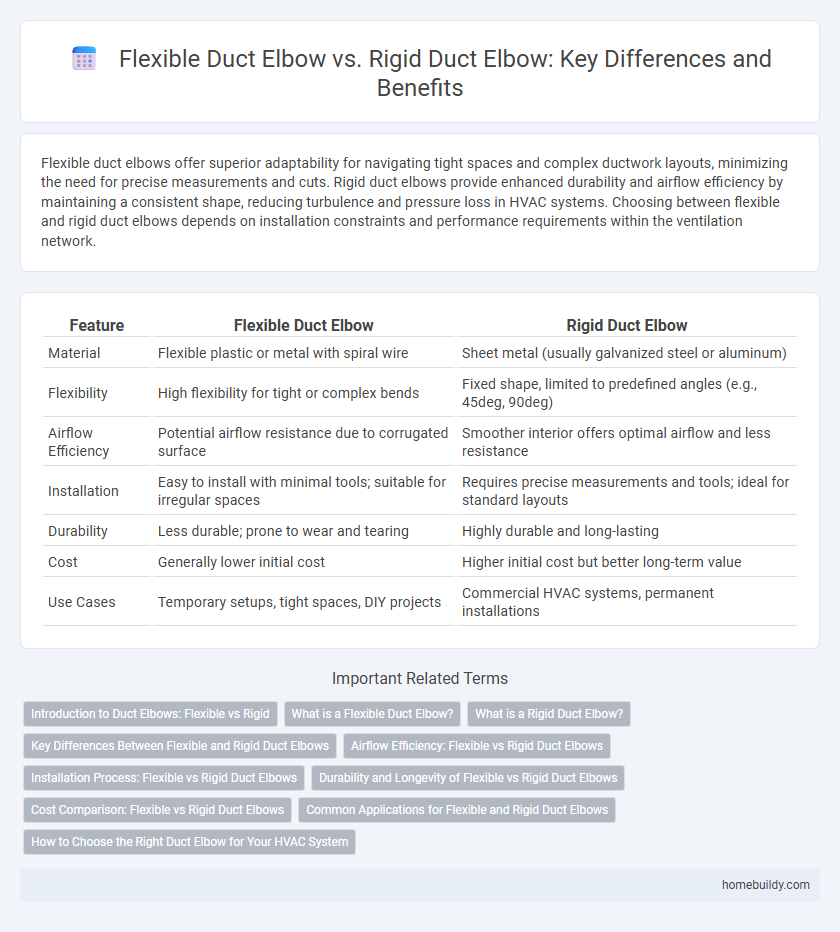Flexible duct elbows offer superior adaptability for navigating tight spaces and complex ductwork layouts, minimizing the need for precise measurements and cuts. Rigid duct elbows provide enhanced durability and airflow efficiency by maintaining a consistent shape, reducing turbulence and pressure loss in HVAC systems. Choosing between flexible and rigid duct elbows depends on installation constraints and performance requirements within the ventilation network.
Table of Comparison
| Feature | Flexible Duct Elbow | Rigid Duct Elbow |
|---|---|---|
| Material | Flexible plastic or metal with spiral wire | Sheet metal (usually galvanized steel or aluminum) |
| Flexibility | High flexibility for tight or complex bends | Fixed shape, limited to predefined angles (e.g., 45deg, 90deg) |
| Airflow Efficiency | Potential airflow resistance due to corrugated surface | Smoother interior offers optimal airflow and less resistance |
| Installation | Easy to install with minimal tools; suitable for irregular spaces | Requires precise measurements and tools; ideal for standard layouts |
| Durability | Less durable; prone to wear and tearing | Highly durable and long-lasting |
| Cost | Generally lower initial cost | Higher initial cost but better long-term value |
| Use Cases | Temporary setups, tight spaces, DIY projects | Commercial HVAC systems, permanent installations |
Introduction to Duct Elbows: Flexible vs Rigid
Duct elbows are essential components in HVAC systems designed to change airflow direction while minimizing pressure loss. Flexible duct elbows offer greater adaptability and ease of installation, accommodating tight spaces and dynamic movement, whereas rigid duct elbows provide durability, consistent airflow, and reduced turbulence due to their smooth, fixed structure. Selecting between flexible and rigid duct elbows depends on specific system requirements, including space constraints, airflow efficiency, and maintenance considerations.
What is a Flexible Duct Elbow?
A flexible duct elbow is a bendable connector used in HVAC systems to navigate airflow through tight or awkward spaces, offering versatility compared to rigid elbows. Made from pliable materials such as reinforced plastic or metalized polyester, it accommodates movement and vibration while minimizing airflow resistance. This flexibility helps reduce installation time and allows for adjustments without compromising duct integrity or airflow efficiency.
What is a Rigid Duct Elbow?
A rigid duct elbow is a fixed, pre-formed component used to change the direction of airflow in HVAC systems, typically made from metal or durable plastic materials. It provides a stable, non-flexible pathway that reduces air resistance and improves ventilation efficiency compared to flexible duct elbows. Rigid duct elbows are preferred in applications requiring consistent airflow, structural integrity, and minimal air leakage.
Key Differences Between Flexible and Rigid Duct Elbows
Flexible duct elbows offer greater adaptability with bend radii that accommodate tight spaces and reduce airflow resistance, while rigid duct elbows provide structural integrity and durability suitable for high-pressure applications. Flexible elbows often consist of spiral wire embedded in a plastic or metalized mylar material, enhancing flexibility but potentially decreasing airflow efficiency compared to smooth, rigid elbows made from galvanized steel or aluminum. Choosing between these options depends on installation environment, airflow requirements, noise levels, and maintenance considerations.
Airflow Efficiency: Flexible vs Rigid Duct Elbows
Flexible duct elbows typically exhibit higher airflow resistance due to their corrugated surfaces, causing turbulence and pressure drops that reduce overall system efficiency. Rigid duct elbows, made from smooth materials like metal, maintain laminar airflow with minimal friction, ensuring superior airflow efficiency and reduced energy consumption. Opting for rigid elbows in HVAC systems significantly improves ventilation performance by minimizing airflow disruption and pressure loss.
Installation Process: Flexible vs Rigid Duct Elbows
Flexible duct elbows simplify the installation process by allowing easier maneuvering around obstacles and requiring fewer precise measurements, which reduces labor time and effort. Rigid duct elbows demand accurate alignment and secure fastening to prevent air leaks, often necessitating additional sealing materials and specialized tools. Choosing flexible elbows can minimize installation complexity, while rigid elbows provide durability but with a more intensive setup.
Durability and Longevity of Flexible vs Rigid Duct Elbows
Flexible duct elbows offer superior adaptability to tight spaces and vibrations but generally have reduced durability compared to rigid duct elbows. Rigid duct elbows, constructed from materials like galvanized steel or aluminum, provide enhanced structural strength and resist wear, ensuring longer lifespan in HVAC systems. Choosing rigid elbows extends system longevity by minimizing maintenance due to their resistance to deformation and corrosion.
Cost Comparison: Flexible vs Rigid Duct Elbows
Flexible duct elbows generally incur lower initial costs due to easier installation and reduced labor time compared to rigid duct elbows, which require precise fabrication and fitting. However, rigid duct elbows offer greater durability and lower maintenance expenses over time, potentially offsetting their higher upfront price. Evaluating the total cost of ownership involves considering installation complexity, material longevity, and long-term performance for both flexible and rigid duct elbows.
Common Applications for Flexible and Rigid Duct Elbows
Flexible duct elbows are commonly used in HVAC systems requiring easy installation around obstacles or in confined spaces, ideal for residential and light commercial applications where adaptability is crucial. Rigid duct elbows are preferred in industrial and commercial settings demanding durability and consistent airflow, such as large-scale ventilation and exhaust systems. The choice between flexible and rigid elbows impacts airflow efficiency, noise levels, and system longevity in various HVAC configurations.
How to Choose the Right Duct Elbow for Your HVAC System
Choosing the right duct elbow for your HVAC system depends on airflow requirements and installation space. Flexible duct elbows offer easy installation and adaptability for tight or irregular spaces, minimizing airflow resistance. Rigid duct elbows provide better air pressure maintenance and durability, ideal for long-term performance in straight or minimally bent duct runs.
Flexible duct elbow vs rigid duct elbow Infographic

 homebuildy.com
homebuildy.com